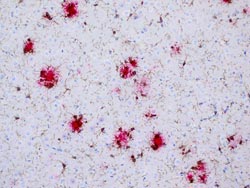New Findings on the Brain’s Immune Cells during Alzheimer’s Disease Progression

Immune cells of the brain, the microglia (brown), cluster around the beta-amyloid deposits (red) in a mouse model for Alzheimer’s disease. Photo: Frank Heppner/ Copyright: Charité<br>
A study by researchers of the Max Delbrück Center for Molecular Medicine (MDC) Berlin-Buch and Charité – Universitätsmedizin Berlin has now shed light on these mysterious microglia during the progression of Alzheimer’s disease. (PLoS One, doi:10.1371/journal.pone.0060921)*.
Dr. Grietje Krabbe of the laboratory of Professor Helmut Kettenmann (MDC) and Dr. Annett Halle of the Neuropathology Department of the Charité headed by Professor Frank Heppner demonstrated that the microglial cells around the deposits do not show the classical activation pattern in mouse models of Alzheimer´s disease.
On the contrary, in the course of the Alzheimer’s disease they lose two of their biological functions. Both their ability to remove cell fragments or harmful structures and their directed process motility towards acute lesions are impaired. The impact of the latter loss-of-function needs further investigation. The plaques consist of protein fragments, the beta-amyloid peptides, which in Alzheimer’s disease are deposited in the brain over the course of years. They are believed to be involved in destroying the nerve cells of the affected patients, resulting in an incurable cognitive decline.
However, just why the microglial cells, which cluster around the deposits, are inactivated or lose their functionality is still not fully understood. The researchers concluded that this process occurs at a very early stage of disease development and is likely triggered by the beta-amyloid. This is confirmed by the fact that the loss-of-function of the microglial cells in the mice could be reversed by beta-amyloid antibodies thereby decreasing the beta-amyloid burden. According to the researchers, the potential to restore microglial function by directed manipulation should be pursued and exploited to develop treatments for Alzheimer’s disease.
**Functional impairment of microglia coincides with beta-amyloid deposition in mice with Alzheimer-like pathology
Grietje Krabbe1,4,*, Annett Halle2,3,*, Vitali Matyash1, Jan L Rinnenthal2, Gina D Eom2, Ulrike Bernhardt2, Kelly R Miller2, Stefan Prokop2, Helmut Kettenmann1,#, Frank L Heppner2,#
1Max Delbrueck Center for Molecular Medicine (MDC), Robert-Roessle-Str. 10, 13125 Berlin, Germany
2Department of Neuropathology, Charité-Universitätsmedizin Berlin, Charitéplatz 1, 10117 Berlin, Germany
3Center of Advanced European Studies and Research (caesar), Ludwig-Erhard-Allee 2, 53175 Bonn, Germany
4Present address: Gladstone Institute of Neurological Disease, 1650 Owens Street, San Francisco, CA 94158, USA
*,# These authors contributed equally to this work.
Contact:
Barbara Bachtler
Press Department
Max Delbrück Center for Molecular Medicine (MDC) Berlin-Buch
in the Helmholtz Association
Robert-Rössle-Straße 10; 13125 Berlin, Germany
Phone: +49 (0) 30 94 06 – 38 96; Fax: +49 (0) 30 94 06 – 38 33
e-mail: presse@mdc-berlin.de
Media Contact
More Information:
http://www.mdc-berlin.de/All latest news from the category: Life Sciences and Chemistry
Articles and reports from the Life Sciences and chemistry area deal with applied and basic research into modern biology, chemistry and human medicine.
Valuable information can be found on a range of life sciences fields including bacteriology, biochemistry, bionics, bioinformatics, biophysics, biotechnology, genetics, geobotany, human biology, marine biology, microbiology, molecular biology, cellular biology, zoology, bioinorganic chemistry, microchemistry and environmental chemistry.
Newest articles

Security vulnerability in browser interface
… allows computer access via graphics card. Researchers at Graz University of Technology were successful with three different side-channel attacks on graphics cards via the WebGPU browser interface. The attacks…

A closer look at mechanochemistry
Ferdi Schüth and his team at the Max Planck Institut für Kohlenforschung in Mülheim/Germany have been studying the phenomena of mechanochemistry for several years. But what actually happens at the…

Severe Vulnerabilities Discovered in Software to Protect Internet Routing
A research team from the National Research Center for Applied Cybersecurity ATHENE led by Prof. Dr. Haya Schulmann has uncovered 18 vulnerabilities in crucial software components of Resource Public Key…





















